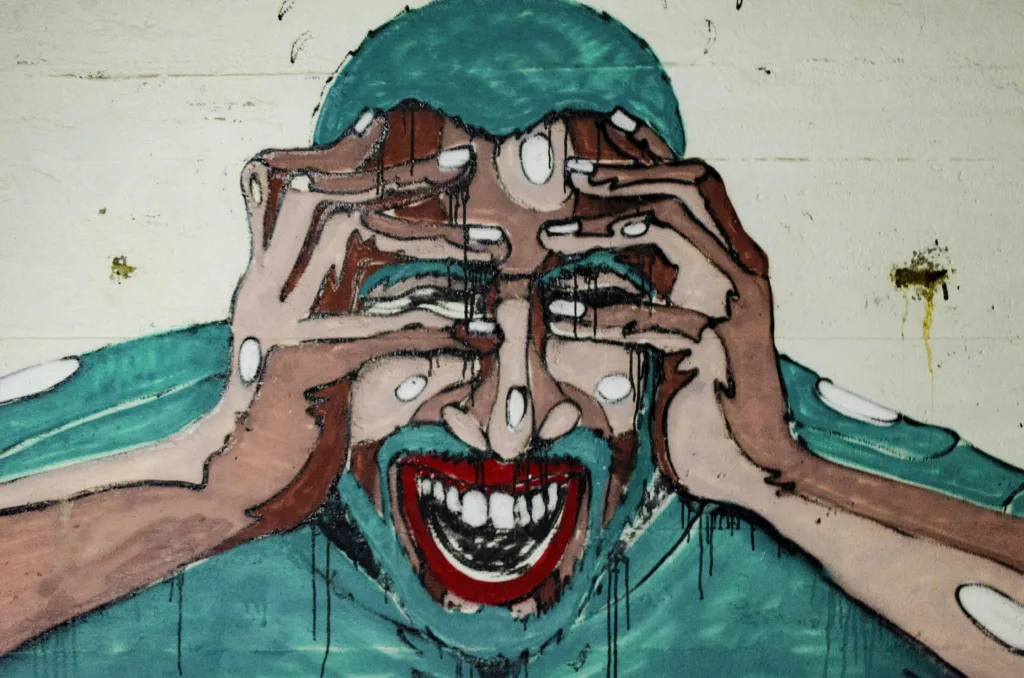Did you know that nearly 1 in 5 adults in the United States experience some form of anxiety disorder each year? This staggering statistic highlights the complexity of distinguishing between Obsessive-Compulsive Disorder (OCD) and anxiety, as both conditions share similar symptoms and can significantly impact a person’s daily life.
Understanding the differences between OCD and anxiety disorders is crucial for proper diagnosis and effective treatment. While both conditions involve distressing thoughts and feelings of fear, they manifest in distinct ways. OCD is characterized by recurring intrusive thoughts (obsessions) and repetitive behaviors (compulsions), whereas anxiety disorders typically involve excessive worry about everyday concerns.
Key Takeaways
- OCD and anxiety disorders can co-occur and share similar symptoms.
- Understanding the distinct characteristics of each condition is key to proper diagnosis.
- OCD involves intrusive thoughts and compulsive behaviors.
- Anxiety disorders typically involve excessive worry about real-life concerns.
- Recognizing the signs of each condition is crucial for seeking appropriate professional help.
- Effective management strategies for mental health depend on accurate diagnosis.
Understanding Anxiety Disorders
Understanding anxiety disorders is crucial for identifying and managing your mental health effectively. Anxiety disorders are among the most prevalent mental health conditions affecting a significant portion of the adult population in the United States annually.
Anxiety disorders encompass a range of conditions that can significantly impact daily life. These disorders are characterized by excessive fear, anxiety, and avoidance behaviors. The presence of chronic anxiety can be debilitating, making everyday tasks challenging.
Common Types of Anxiety Disorders
There are several common types of anxiety disorders. These include:
- Generalized Anxiety Disorder (GAD): Characterized by persistent and excessive worry about various things that is difficult to control and lasts for at least six months.
- Social Anxiety Disorder: Involves intense fear of social situations where you might be judged, embarrassed, or humiliated, leading to avoidance behaviors.
- Panic Disorder: Marked by recurring unexpected panic attacks and persistent worry about having future attacks.
- Specific Phobias: Intense fears of specific objects or situations that cause immediate anxiety and often lead to avoidance behaviors.
- Agoraphobia: Fear and anxiety about places or situations where escape might be difficult or help might not be available if panic symptoms occur.
Understanding these different types of anxiety disorders is crucial for proper diagnosis and treatment, as each type may require specific therapeutic approaches. Recognizing the characteristics of your anxiety can help you seek the right help, whether it’s for generalized anxiety or another form of disorder.
What is Obsessive-Compulsive Disorder (OCD)?
OCD, or Obsessive-Compulsive Disorder, is a chronic condition characterized by intrusive thoughts and repetitive behaviors. It’s a mental health disorder that affects a significant number of people worldwide, causing distress and impairing daily functioning.
Defining Obsessions
Obsessions are persistent, unwanted thoughts, images, or urges that cause significant anxiety or distress. These intrusive mental intrusions can be about various themes, including fear of contamination, concerns about order or symmetry, intrusive violent or sexual thoughts, and religious or moral obsessions. They intrude when you’re trying to think about or do other things, making it difficult to focus on daily activities.
Understanding Compulsions
Compulsions are repetitive behaviors or mental acts that a person feels compelled to perform in response to an obsession. These can include actions like excessive handwashing, checking, counting, or arranging, aimed at reducing anxiety or preventing a perceived threat. While these actions may provide temporary relief, they are often excessive and not realistically connected to the issue they’re designed to address.
Impact of OCD on Daily Functioning
The symptoms of OCD can significantly impact daily functioning. Consuming considerable time, often more than an hour a day, and causing marked distress, OCD can interfere with normal routines, work or school performance, and social activities. Unlike occasional worries or rituals, OCD symptoms are time-consuming and interfere with important activities a person values, affecting their overall quality of life.
The Relationship Between OCD and Anxiety
OCD and anxiety, though distinct mental health conditions, share a complex and intertwined relationship. Understanding this connection is crucial for both diagnosis and treatment.
Historical Context
The classification of OCD in relation to anxiety disorders has undergone significant changes. Previously, the Diagnostic and Statistical Manual of Mental Disorders, 4th edition (DSM-IV), categorized OCD as an anxiety disorder. However, the current DSM-5-TR has reclassified OCD under “Obsessive-Compulsive and Related Disorders,” acknowledging its unique characteristics while still recognizing its association with anxiety.
| DSM Edition | Classification of OCD |
|---|---|
| DSM-IV | Anxiety Disorder |
| DSM-5-TR | Obsessive-Compulsive and Related Disorders |
Manifestation of Anxiety in OCD
In OCD, anxiety is triggered by intrusive thoughts or obsessions, leading to compulsions aimed at reducing the associated distress. This cycle is distinctive to OCD and differs from general anxiety disorders, where worries typically revolve around real-life concerns such as health, finances, or relationships.
Differentiating OCD and Anxiety
The key difference lies in the nature of the thoughts and the behaviors they provoke. OCD is characterized by irrational or intrusive thoughts followed by specific rituals or compulsions, whereas anxiety disorders involve more generalized worries without the distinct compulsive behaviors. Recognizing these differences is essential for developing targeted treatment plans that address both the anxiety and the obsessive-compulsive symptoms effectively.
Distinguishing Features: OCD vs. Anxiety
The line between OCD and anxiety can be blurry, making it essential to identify their distinguishing features. While both conditions can manifest with fear and apprehension, their underlying mechanisms and manifestations differ significantly.
Thought Patterns and Triggers
The thought patterns in OCD and anxiety disorders differ significantly in their nature and content. In OCD, thoughts are typically intrusive, unwanted, and often misaligned with your values, such as violent or sexual thoughts. On the other hand, anxiety disorders involve excessive worry about realistic concerns like health, finances, or relationships.
Triggers for OCD are specific to the person’s obsessions and can include situations, objects, or even certain numbers or colors. In contrast, anxiety triggers tend to be directly related to the source of worry, such as public speaking for someone with social anxiety.
Behavioral Responses
The behavioral response in OCD involves compulsions or rituals performed according to strict rules to neutralize anxiety. For example, a person with OCD might engage in repetitive handwashing or ordering objects. In contrast, anxiety disorders typically lead to avoidance of anxiety-provoking situations rather than ritualistic behaviors.
| Condition | Thought Patterns | Behavioral Responses |
|---|---|---|
| OCD | Intrusive, unwanted thoughts | Compulsions or rituals |
| Anxiety Disorders | Excessive worry about realistic concerns | Avoidance of anxiety-provoking situations |
Emotional Experiences
Emotionally, OCD creates a cycle of temporary relief followed by returning anxiety when compulsions are completed. In contrast, anxiety disorders involve more persistent worry without this cyclical pattern. Understanding these differences can help you identify whether your symptoms align more closely with OCD or an anxiety disorder, guiding you toward appropriate treatment.
By recognizing the distinct features of OCD and anxiety, you can better navigate your mental health journey and seek the right support.
Common Symptoms That Overlap
The line between OCD and anxiety can be blurry, with both conditions sharing several common symptoms. This overlap can complicate the diagnosis, making it essential to understand the nuances of each condition.
Shared Physical Symptoms
Both OCD and anxiety disorders can manifest with physical symptoms that are quite similar. These include increased heart rate, shortness of breath, sweating, trembling, and sleep disturbances. Such symptoms can make it challenging to differentiate between the two conditions based solely on physical manifestations.
| Symptom | OCD | Anxiety Disorders |
|---|---|---|
| Increased Heart Rate | Common during obsessive episodes | Frequent during anxiety attacks |
| Sleep Disturbances | Often due to intrusive thoughts | Can be caused by persistent worry |
Similar Thought Patterns
The thought patterns in OCD and anxiety disorders also show significant overlap. Both conditions involve persistent worry and rumination, though the content and focus of these thoughts can differ significantly. Catastrophic thinking is another commonality, where individuals anticipate the worst possible outcomes.
“The overlap in thought patterns between OCD and anxiety disorders highlights the complexity of diagnosing these conditions.”
Overlapping Emotional Responses
The emotional responses associated with OCD and anxiety disorders can also be quite similar. Individuals with either condition may experience heightened vigilance and hyperawareness of potential threats, constantly scanning their environment or internal sensations for signs of danger. Avoidance behaviors are also common, though the motivations behind these behaviors can differ.
Understanding these overlapping symptoms is crucial for developing effective treatment plans that address the specific needs of individuals with OCD or anxiety disorders.
Unique Signs That Point to OCD
While anxiety and OCD can share similar symptoms, there are unique indicators that point to OCD. Understanding these distinct characteristics is essential for an accurate diagnosis and effective treatment plan. You might be wondering how to differentiate between the two, and it’s crucial to recognize the specific signs that are more indicative of OCD.
Specific Types of Intrusive Thoughts
One of the most distinctive features of OCD is the presence of specific types of intrusive thoughts that differ significantly from general anxiety worries. These thoughts often involve taboo or distressing content that contradicts your values, such as thoughts of harming loved ones, sexual obsessions, or religious blasphemy, causing significant moral distress. For example, a person with OCD might experience intrusive thoughts about contamination, which can lead to excessive cleaning or avoidance behaviors. These obsessions are experienced as intrusive and unwanted, feeling foreign to the person experiencing them.
Ritualistic Behaviors
Ritualistic behaviors in OCD are performed according to strict rules or patterns and must be done “just right” to provide relief. You might find yourself engaging in repetitive behaviors such as washing hands a specific number of times, checking locks in a particular sequence, or counting or tapping objects. These compulsions are often time-consuming, taking more than an hour per day, and significantly interfere with your normal routines, occupational functioning, and social activities. For instance, a person might feel compelled to check the stove multiple times before leaving the house, even if it’s irrational.
The Obsession-Compulsion Cycle
The obsession-compulsion cycle is unique to OCD and involves an intrusive thought causing anxiety, followed by a compulsion to reduce that anxiety, temporary relief, and then the return of the obsession, creating a self-perpetuating cycle. This cycle can be distressing and disrupt daily life. Unlike adaptive behaviors in anxiety disorders, OCD compulsions are not realistically connected to what they’re designed to prevent. For example, checking the stove 20 times is excessive for preventing a fire, illustrating the irrational nature of OCD compulsions.
Unique Signs That Point to Anxiety Disorders
Understanding the unique signs of anxiety disorders is crucial for accurate diagnosis and treatment. You may be experiencing anxiety, but how do you know if it’s an anxiety disorder? Let’s explore the distinct features that characterize anxiety disorders.
Worry About Real-Life Concerns
One of the primary characteristics of anxiety disorders is excessive worry about real-life concerns. You might find yourself worrying about your health, finances, relationships, work performance, or future events. Unlike OCD, where fears are often irrational or implausible, anxiety disorders typically involve worries that are grounded in reality. For example, a person with generalized anxiety disorder might worry excessively about their child’s safety in realistic scenarios.
- Worry is pervasive across multiple life domains.
- You may find it difficult to control your worry, shifting from one concern to another throughout the day.
- The content of your anxious thoughts typically reflects your actual values and concerns.
Avoidance Behaviors
Avoidance is a hallmark of anxiety disorders. You might actively steer clear of situations that trigger your anxiety, such as public speaking, crowds, or flying, depending on the specific anxiety disorder. This avoidance can significantly impact your daily life, making it essential to address these behaviors.
For instance, if you have a fear of public speaking, you might avoid presentations or social gatherings. Recognizing these avoidance behaviors can help you understand your anxiety disorder better.
Physical Manifestations of Anxiety
Anxiety disorders often involve prominent physical symptoms. You might experience chronic muscle tension, fatigue, restlessness, or sleep disturbances that can last for extended periods. These physical manifestations can be distressing and disrupt your daily functioning.
It’s essential to acknowledge these physical symptoms as part of your anxiety disorder, as they can significantly impact your overall well-being.
When to Seek Professional Help
Recognizing the signs that indicate the need for professional intervention is vital for individuals dealing with OCD or anxiety. If you’re experiencing symptoms that interfere with your daily life, it’s essential to seek help.
Warning Signs That Require Attention
It’s crucial to seek professional help when symptoms of anxiety or OCD begin to interfere with your daily functioning, relationships, work performance, or quality of life. Some warning signs that require immediate attention include:
- Thoughts of harming yourself or others
- Inability to perform basic self-care activities
- Spending more than an hour a day engaged in rituals or compulsive behaviors
- Anxiety preventing you from engaging in activities you once enjoyed
A study found that individuals with both OCD and Generalized Anxiety Disorder (GAD) were more likely to experience severe anxiety, avoidant behavior, and other comorbid conditions.
Finding the Right Mental Health Professional
Finding the right mental health professional is essential for effective treatment. Psychiatrists can prescribe medication, while psychologists and licensed therapists specialize in therapeutic approaches like Cognitive Behavioral Therapy (CBT). When seeking help, look for professionals with specific experience treating anxiety disorders and OCD.
| Professional | Specialization | Services Offered |
|---|---|---|
| Psychiatrist | Mental health | Medication prescription |
| Psychologist | Therapy and counseling | CBT and other therapeutic approaches |
| Licensed Therapist | Therapy and counseling | CBT and other therapeutic approaches |
A qualified professional can provide an accurate diagnosis and develop a comprehensive treatment plan addressing both OCD and anxiety.
Diagnostic Process for OCD and Anxiety
The journey to determining if your symptoms are related to OCD, anxiety, or both starts with a comprehensive evaluation. This process is crucial for understanding your condition and developing an effective treatment plan.
Clinical Assessments and Questionnaires
During the diagnostic process, mental health professionals often begin with a comprehensive clinical interview. This involves discussing your symptoms, their onset, duration, and impact on your daily functioning. Standardized assessment tools and questionnaires, such as the Yale-Brown Obsessive Compulsive Scale (Y-BOCS) for OCD or the Generalized Anxiety Disorder 7-item (GAD-7) scale, are used to quantify symptom severity. These tools help clinicians understand the extent of your symptoms and their effect on your life.
Differential Diagnosis Considerations
Differential diagnosis is a critical step in the evaluation process. Many conditions share overlapping symptoms with OCD and anxiety disorders, including depression, PTSD, specific phobias, and certain neurological conditions. Medical evaluations may be conducted to rule out physical conditions that can mimic anxiety symptoms, such as thyroid disorders or cardiac issues. Your clinician will assess whether your symptoms better align with the diagnostic criteria for OCD, an anxiety disorder, or both, considering the specific nature of your thoughts, behaviors, and emotional responses.
What to Expect During Evaluation
During the evaluation, you can expect a thorough examination of your symptoms and medical history. Your clinician will likely explore your family history, as both OCD and anxiety disorders have genetic components. Studies have shown heritability rates of 40-50% for both conditions, indicating a significant genetic influence. The diagnostic process is not just about labeling your condition but understanding its unique manifestations in your life. This comprehensive approach helps in developing a personalized treatment plan that addresses your specific symptoms and needs.
Treatment Approaches for OCD and Anxiety
You have several options when it comes to treating OCD and anxiety, including various forms of therapy and medication. Both conditions can be managed effectively with the right treatment approach.
The most effective treatments often involve a combination of psychological therapies and, in some cases, medication. Understanding the different options available can help you make informed decisions about your care.
Cognitive Behavioral Therapy (CBT)
CBT is a first-line psychological treatment for both OCD and anxiety disorders. It helps you identify and challenge unhelpful thought patterns and beliefs, replacing them with more realistic and adaptive ways of thinking. Through CBT, you can learn to manage your symptoms more effectively.
Exposure and Response Prevention (ERP)
ERP is a specialized form of CBT that is particularly effective for OCD. It involves gradual exposure to anxiety-provoking situations or thoughts while preventing the compulsive response. By facing your fears without performing compulsions, you can break the obsession-compulsion cycle over time.
Medication Options
Medication, such as selective serotonin reuptake inhibitors (SSRIs), is commonly used to treat both OCD and anxiety. Typically, higher doses are needed for OCD than for anxiety disorders. Other medication options may include serotonin-norepinephrine reuptake inhibitors (SNRIs) and tricyclic antidepressants.
Living With and Managing Symptoms
Living with OCD or anxiety disorders can be challenging, but with the right strategies, you can lead a fulfilling life. Developing a personalized symptom management plan with your healthcare provider is essential. This plan may include a combination of medication, therapy, lifestyle changes, and stress reduction techniques. Mindfulness and meditation practices have shown promising results in helping people manage both anxiety and OCD symptoms. Building a strong support network and learning to recognize early warning signs of symptom escalation are also crucial. With proper treatment, support, and self-management strategies, many people experience significant symptom reduction and improved quality of life over time.
It’s crucial to remember that having OCD or anxiety doesn’t define you as a person. Research continues to advance our understanding of these conditions, with new treatments being developed. If you or someone you know is experiencing suicidal thoughts, seek immediate professional help. By staying informed and proactive, you can manage your symptoms and lead a healthier, more fulfilling life.








